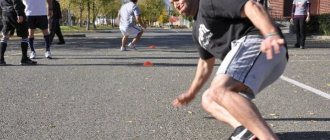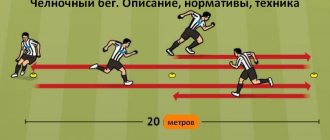© Daxiao Productions - stock.adobe.com
Share:
Shuttle running is a type of cardio exercise widespread throughout the world, aimed at developing the speed and strength qualities of an athlete. When performing a shuttle run, the athlete must run the same distance in the forward and reverse directions several times with a 180-degree turn at the end point of the distance. The most popular technique among athletes is shuttle running 10x10, 3x10.
Benefit
This method of training is useful in that it helps to increase the explosive strength of the leg muscles, improve the functioning of the entire cardiovascular system, develop coordination and strength endurance. Shuttle running standards are used to assess the physical fitness of not only athletes, but also employees of various law enforcement agencies.
Usually shuttle running is carried out over short distances from 10 to 30 meters, but in rare cases the distance can reach 100 meters. Due to its many-sided benefits, this exercise has gained popularity in fitness, crossfit, various martial arts, and is also included in the mandatory physical training program in schools, specialized academies under government agencies and in the Armed Forces of the Russian Federation.
Today we will figure out how to do shuttle running correctly, as well as what are the practical benefits of this exercise on the human body from the point of view of the all-round development of an athlete.
How to run
Shuttle running consists of several phases:
- Warm-up: necessary to prepare the heart, blood vessels, lungs and muscles, should take at least 10-15 minutes. It usually includes simple general strengthening exercises, moderate-intensity running or walking, and in some cases, special running exercises to develop technique.
- Stretching: This can be used to complete the warm-up and the entire workout. In the first case, 2-3 exercises on the muscles of the lower extremities are suitable, and in the latter, you should carefully stretch the entire body.
- Direct running: it consists of circular repetitions - 10 times 10 m with a turn. First come the commands - to start, attention, march. At this time, you need to take the correct posture and group your body for the upcoming load.
You shouldn’t take breaks between laps - they move into each other without stopping, and by the last lap you need to speed up, on the contrary. The technique of execution does not depend on the number of repetitions.
An important trick is to distribute your forces correctly! Don't start running with maximum effort. As practice shows, about 60% of the energy is spent on the last laps, so you need to save yourself for the final push. Each lap occurs with a slight acceleration.
Let's look at all the stages briefly.
Exercise technique
The shuttle running technique has several varieties, the choice of which depends on the distance the shuttle run is performed: 10x10, 3x10, 4x9. However, at your discretion, you can increase the distance several times - be guided by your level of physical fitness and well-being.
One way or another, the shuttle running technique is almost the same for any distance. The only factor that should be taken into account is that in short-distance running the athlete immediately begins to perform the exercise with the greatest intensity, using all his power potential; with a longer shuttle run (for example, 10x10 or 4x100), the first 4-6 segments should be performed at a normal pace, trying not to expend a large amount of energy, so as not to become exhausted ahead of time. It’s better to leave most of your body’s speed-strength resources for last in order to cover the required distance in the shortest possible time period and show a truly outstanding result.
The exercise should be performed as follows:
Initial position
Classic starting position: we place the supporting leg forward, trying to keep the entire center of gravity above it. The quadriceps of the supporting leg is tense, like a spring, the body is tilted slightly forward, the back is straight, we keep our hands at the level of the ribs. The start should be as explosive and fast as possible in order to overcome the first segment in the minimum time. For a truly explosive start, we need strong and well-developed legs, so pay more attention to exercises that develop explosive power in the quadriceps: barbell squats with a pause at the bottom, sumo deadlifts, box jumps, jump squats, etc.
Another option for the starting position is a low start:
© Daxiao Productions - stock.adobe.com
Running speed
During the race itself, we need maximum speed. To do this, after each step you should not land on your entire foot, but only on your toe. To develop this skill, replace your standard cardio with jumping rope, then the Lisfranc joint will adapt to constantly landing on your toes, and shuttle running will be much easier.
© Daxiao Productions - stock.adobe.com
U-turn
At the end of each segment you need to make a 180 degree turn. To do this, you need to sharply reduce the speed and take a stopping step, turning the foot of your front leg 90 degrees in the direction of the turn - this movement will slow you down, but will not completely extinguish the inertia.
© Daxiao Productions - stock.adobe.com
Acceleration
In the last stretch, you need to squeeze the maximum out of your body and make one last explosive acceleration, without thinking that you will soon need to stop, you must continue to increase the speed right until the finish line.
You can see a video of the shuttle race below. It very clearly shows the technique of performing shuttle running:
What is GTO
The state program of the all-Union physical culture and sports complex “Ready for Labor and Defense” was developed at the very beginning of the 30s of the last century and lasted until 1991. The Komsomol took the initiative to hold sports competitions to assess the level of physical fitness of young people and establish special standards for participants. Those who met the standards received the “Ready for Labor and Defense” insignia.
In May 1930, the Komsomolskaya Pravda newspaper notified the entire USSR about this initiative. The All-Union Council of Physical Culture accepted the idea for consideration, and the project soon went into production. On March 11, 1931, the GTO complex was approved and became the normative basis for the physical education of citizens of the USSR. Already in the first year of the program’s introduction, 24,000 people received insignia.
Since 2013, the idea of a physical culture and sports complex began to be revived in a modern format, and on March 24, 2014, the Decree of the President of the Russian Federation “On the All-Russian physical culture and sports complex “Ready for Labor and Defense”” was issued.
Common mistakes
When learning the technique of performing the 10x10 shuttle run, many beginning athletes encounter the following problems that prevent them from getting the most out of this exercise:
- Incorrect load distribution. If you run 10 equal sections of shuttle running, your endurance will usually run out after the first half. To avoid this, you need to start running at medium intensity, trying to increase the speed with each segment, using the explosive power of the leg muscles.
- Load volume too large. Don't go overboard with your training volume when it comes to high-intensity cardio like this, especially if you suffer from various types of cardiovascular diseases. You will most likely end up doing more harm than good.
- Stopping too slowly before turning. There is no need to reduce your running speed in order to turn around calmly; you need to turn around in one movement, sharply turning your leg 90 degrees - this way you will maintain the force of inertia and not reduce your speed to zero.
- Incorrect breathing rate. While performing the shuttle run, you should breathe in the “2-2” mode, taking two steps while inhaling and two steps while exhaling. You should breathe only through your nose.
- Don't forget to warm up properly, as shuttle running involves engaging a huge number of muscles, joints and ligaments.
© Daxiao Productions - stock.adobe.com
Who shouldn't
Such running is a serious load that not everyone can afford. There are some conditions and illnesses where you should not run. These include:
- hypertonic disease;
- ischemic disease;
- serious rhythm disturbances;
- injuries of the musculoskeletal system, as well as anatomical changes: hernia, protrusion, etc.;
- pregnancy and breastfeeding;
- vascular lesions of the arteries and veins of the brain;
- period after stroke and heart attack;
- acute inflammatory process, including infectious;
- uncontrolled bronchial asthma;
- complicated diabetes mellitus;
- severe breathing problems.
If there is reason to suspect any of the above, you should immediately go to the doctor. He will conduct an examination and help you cure the problem in time and adjust your training.
Training program
This shuttle running program is designed for beginners who are just starting to get acquainted with this exercise. It consists of only 6 workouts, between which you should take a break of 2-3 days so that the body has time to replenish energy costs. However, by repeating it several times, you can significantly improve your maximum result in the shuttle run. It's best to do these workouts at a track or track facility. There you can accurately measure the required distance.
| Training no.: | Number of approaches and required distance: |
| 1 | Perform the 4x9 shuttle run three times. |
| 2 | Complete the 4x9 run five times. |
| 3 | Complete the 4x15 run three times. |
| 4 | Complete the 4x15 run five times. |
| 5 | Complete the 4x20 race three times. |
| 6 | Complete the 10x10 race once. |
Warm-up
For a good warm-up you should:
- Walk on a treadmill at a moderate pace for 10 minutes or jog;
- do exercises: squats, leg swings to the side, lunges, body bends, shoulder and arm rotation, jumping rope;
- you can include practicing the starting position and running for 5, 10 and 15 meters with a turn, as well as running with a high hip for a short distance or running for a distance of 60-80 m with acceleration.
A combination of general strengthening and running exercises will prepare the body for the main section.
Shuttle run standards 10x10
Shuttle running is part of the mandatory physical training program for military personnel in various units. The table below presents the current standards in force for military personnel serving under contract and military personnel from special forces units, approved by orders of the Ministry of Internal Affairs of the Russian Federation.
| Contract workers | Men | Women | ||
| Up to 30 years old | Over 30 years old | Up to 25 years | Over 25 years old | |
| 28.5 sec. | 29.5 sec. | 38 sec. | 39 sec. | |
| Special Forces | 25 sec. | – | ||
Shuttle run standards 3x10
The standards for schoolchildren (boys and girls) are presented below. You can download and print the table using the link.
| Age | Level of development of the CS | ||||
| short | below the average | average | above average | high | |
Boys | |||||
| 7 | 11.2 and more | 11,1-10,9 | 10,8-10,3 | 10,2-10,0 | 9,9 |
| 8 | 11,4 –//– | 10,3-10,1 | 10,0-9,5 | 9,4-9,2 | 9,1 –//– |
| 9 | 10,4 –//– | 10,3-10,0 | 9,9-9,3 | 9,2-8,9 | 8,8 –//– |
| 10 | 9,9 –//– | 9,8-9,6 | 9,5-9,0 | 8,9-8,7 | 8,6 –//– |
| 11 | 9,7 –//– | 9,6-9,4 | 9,3-8,8 | 8,7-8,5 | 8,4 –//– |
| 12 | 9,22 –//– | 9,1-9,0 | 8,99-8,5 | 8,4-8,3 | 8,2 –//– |
| 13 | 9,3 –//– | 9,2-9,1 | 9,0-8,5 | 8,4-8,3 | 8,2 –//– |
| 14 | 9,0 –//– | 8,9-8,7 | 8,6-8,1 | 8,0-7,8 | 7,7 –//– |
| 15 | 8,5 –//– | 8,4-8,3 | 8,2-7,9 | 7,8-7,7 | 7,6 –//– |
| 16 | 8,1 –//– | 8,0-7,9 | 7,9-7,5 | 7,4-7,3 | 7,2 –//– |
| 17 | 8,5 –//– | 8,4-8,2 | 8,1-7,6 | 7,5-7,3 | 7,2 –//– |
Girls | |||||
| 7 | 11.7 and more | 11,6-11,4 | 11,3-10,6 | 10,5-10,3 | 10,2 |
| 8 | 11,2 –//– | 11,1-10,8 | 10,7-10,1 | 10,0-9,8 | 9,7 –//– |
| 9 | 10,8 –//– | 10,7-10,4 | 10,3-9,7 | 9,6-9,4 | 9,3 –//– |
| 10 | 10,4 –//– | 10,3-10,1 | 10,0-9,5 | 9,4-9,2 | 9,1 –//– |
| 11 | 10,1 –//– | 10,0-9,8 | 9,7-9,1 | 9,0-8,8 | 8,7 –//– |
| 12 | 10,0 –//– | 9,9-9,7 | 9,6-9,1 | 9,0-8,8 | 8,7 –//– |
| 13 | 10,0 –//– | 9,9-9,7 | 9,6-9,0 | 8,9-8,7 | 8,6 –//– |
| 14 | 9,9 –//– | 9,8-9,6 | 9,5-8,9 | 8,8-8,6 | 8,5 –//– |
| 15 | 9,7 –//– | 9,6-9,4 | 9,3-8,8 | 8,7-8,5 | 8,4 –//– |
| 16 | 9,5 –//– | 9,4-9,2 | 9,1-8,4 | 8,6-8,5 | 8,4 –//– |
| 17 | 9,7 –//– | 9,6-9,4 | 9,3-9,1 | 9,0-8,8 | 8,7 –//– |
Recipes for healthy eating
Oatmeal with apple
- 2.8 g Protein
- 1.9 g Fat
- 22.0 g Carbohydrates
- 135.2 kcal
30 min.
- #vegetarian dish
- #second course
- #dietary
- #breakfast
- #porridge
- #cinnamon
- #Brown sugar
- #honey
- #milk
- #oatmeal
- #snack
- #granulated sugar
- #apples
Other recipes











